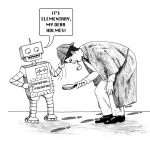Matchmaking for Kidneys. SIAM News, December 2008.
The waiting time for kidney transplants has been shortened by graph-theoretic algorithms that look for cycles—two, three, or more donor-recipient pairs linked together in a chain. (The idea was dramatized on the TV show Grey’s Anatomy.)
Ramping Up To Multiscale, Biomedical Computation Review, Spring 2006.
Computer scientists and biologists have made huge strides in designing realistic models of the human body, from individual cells to whole organs. The most difficult thing to do, though, is to integrate models that work at different scales. For example, how does the flow of ions through individual cells precipitate an arrhythmia of the whole heart? This article describes some approaches that work.
Making Sense of Stents. SIAM News, May 2004, 1-3.
In less than 20 years, stents (which prop open an occluded artery) have gone from an experimental procedure to a routine treatment for cardiovascular disease. But about a quarter of stented arteries eventually clog up again. Mathematicians are developing models that explain why and what we can do about it.
Making Sense of a Heart Gone Wild, Science, 6 February 2004.
You’ve seen automatic defibrillators in medical dramas on TV. You know that they bring people back to life who would otherwise die in minutes. But did you realize that no one understands why they work? Mathematical models have identified two possible explanations. The models may also help engineers design pain-free implantable defibrillators for people who are susceptible to arrhythmias.
Write a Poem, Save a Frog. Andover, Winter 2011, p. 22.
Kerry Kriger launches Save the Frogs!, the country’s first nonprofit organization dedicated to conservation of amphibians. The most neglected animals on most endangered species list finally have an advocate who speaks their language (literally!).
No Age Limits: Can Mathematical Models of Fish Shed Light on Human Aging? SIAM News, April 2005, 4-6.
The rockfish is an amazing fish: Some species live up to 200 years, but others live for only a dozen years or so. Mathematical models suggest that the variety of life spans evolved because they enabled the species to avoid competing with one another. Not too much here about humans, actually, in spite of the title.





